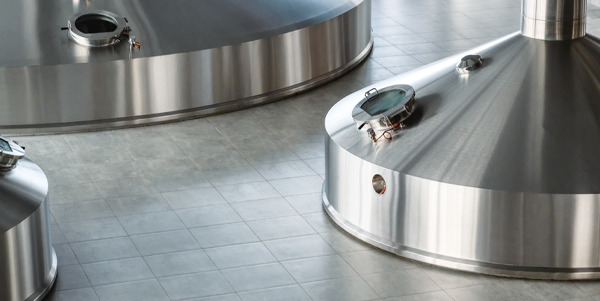Environmental change has become more evident in the past two decades, as we witness the effect of wildfires, droughts, floods, melting of glaciers, and rising sea levels. According to the United Nations’ climate science panel, human-made carbon dioxide emissions must fall by about 45% by 2030 from 2010 concentrations to reach net zero by mid-century and give the world a chance of limiting global warming to 1.5 °C to avoid its worst consequences.
A rationale for the beer industry to act on the reduction of greenhouse gas discharges:
- Today, the society has become increasingly conscious of the quality of the environment as indicated by the Boston Consulting Group[1] and more individuals are behaving accordingly. Companies that don’t embrace and support the need for change in this field, run the risk of being at a competitive disadvantage. The image of the corporation impacts customers’ loyalty and brand promotion must align with the consumers ’values.
- This economic sector highly depends on the availability of natural resources such as water, barley, hops, wheat, rice, and the decrease of these key ingredients due to global warming is alarming. A recent article published by Mozny, M., et al., predicts a decline in hop yield and alpha content around 4 to 18% by 2050. Mitigating the impact of climate change for the preservation of these natural resources is crucial for the industry.
- Focusing on an area such as water and energy usage can greatly lower carbon emissions and lower cost. As an example, in a 500,000 hL plant, a reduction in electrical consumption of 1 kWh/hL at $.09 kWh, will result in an annual saving of $45k. It is essential for the company to provide the correct monitoring system and incite their personnel for improvement by setting challenging targets. Some undertakings may be impractical due to high capital investment, but the effort for continuous improvement is rewarding.
- Finally, we all have a moral obligation and must work accordingly. It’s the responsibility of the organization stewardship to nurture initiatives towards carbon reduction emissions.
The Greenhouse Gas Protocol classifies carbon emissions in three broad categories:
- Scope 1—Emissions under the management’s control such as the brewery and logistics activities.
- Scope 2—Emissions connected with the plant power supply such as the electrical and steam generation. In this field, the necessary resources could be restricted due to the local infrastructure. However, the organization’s management could consider other sources of greener energy such as solar, wind turbines, biogas, biomass, as some of these alternatives are getting more economically viable.
- Scope 3—Emissions associated with the supply chain such as the transportation of the direct and indirect material. For a smaller brewing facility this scope maybe more difficult to impact as the alternatives may be limited.
Brewery Scope 1 Emissions: Key Area of Influence
- Plant design and technology cover the selection of the appropriate equipment for the best output. This field includes projects such as wort boiling energy recovery, boiler stack heat recovery system, dual plant refrigeration suction pressure, in line-metering installation, beer pasteurizer (latest technology) and installation of variable-frequency drives on key motors.
- Plant operations performance consists of establishing a management and a reporting system with regular meetings to optimize brewery operation such as fixing an optimum plant air pressure, leveraging the production schedule to minimize electrical peak usage, monitoring boiler efficiency, water and power consumption to lessen waste and engaging employees in the right behaviours.
- Plant maintenance ensures that all equipment is running as per design to optimize plant output and performance. This area of influence includes initiatives such as monitoring leaks, in air, steam and water to reduce waste and increasing packaging line efficiency to lower run time.
Leveraging Maintenance to Reduce Carbon Emissions
A well-implemented maintenance program ensures that equipment or components are performing at an acceptable level. Often, brewery personnel tend to undervalue the impact of brewery operations- and maintenance-focused activities in comparison to costly capital investments projects to achieve reduction in carbon emissions. This article explores how to remedy this situation.
Preventive Maintenance and Carbon Emissions
The P-F Curve (Potential Failure—Failure Curve) is a simplistic but useful model for understanding the rationale for preventive maintenance. It illustrates how the condition of an asset changes over a period of time. When machines are originally installed and commissioned, they perform at their design level (Figure 1). As time progresses, they deteriorate, e.g., bearing wear or fouling of a heat exchanger. Initially, the effect is modest (point A). However, if the situation goes uncorrected, the system will move to Point C (running outside its upper or lower control limits) and a mechanical failure will happen. A breakdown occurs at the phase below the minimum operating condition and the equipment becomes incapable of functioning properly.
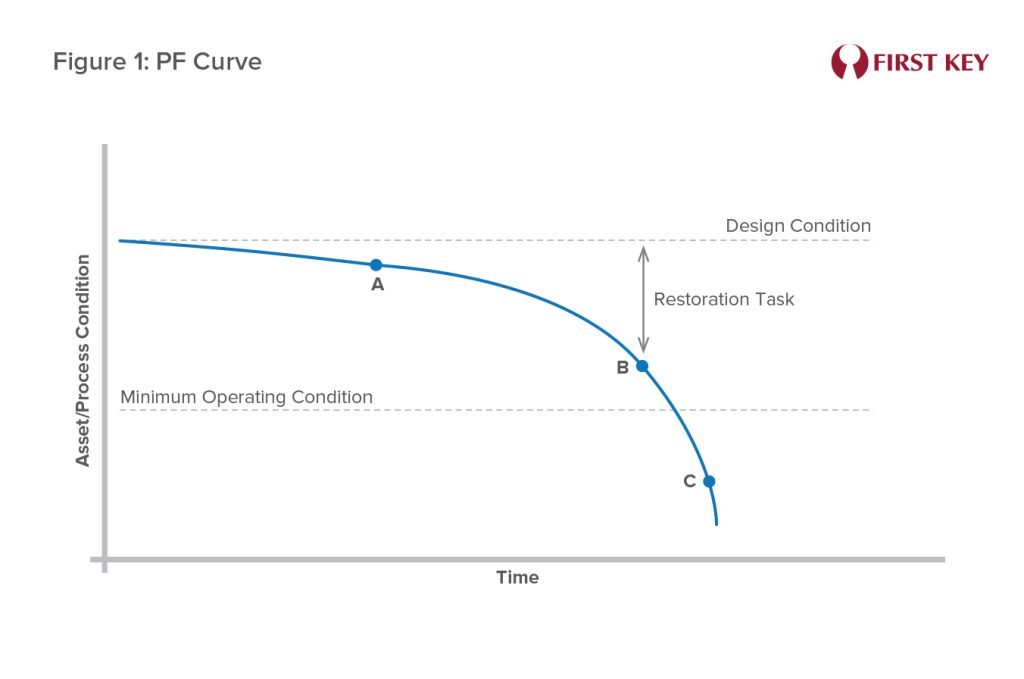
The aim of preventive maintenance therefore is to find the relevant deterioration in components that have an impact on global warming and address them at the most cost-effective time (Figure 1, Point B).
Developing a Carbon Emissions-Focused Preventive Maintenance Plan
The composition of a carbon emissions maintenance plan requires the identification of the correct tasks and their addition to the program. The use of a very simplified Reliability Centered Maintenance (RCM) approach can facilitate the exercise. Here are the required steps:
- Identify the key equipment/processes that influence carbon emissions.
- Divide the selected equipment/process into its constituent components.
- Define the failure modes for each component that drive excessive carbon emissions.
- Define the effects of these failure modes.
- Define the appropriate maintenance tasks to counteract these failure modes.
- Update the equipment preventive maintenance plans with the preventive maintenance tasks as outline in step “E.”
Each of these steps will be explained using a wort cooling process and the example will describe the analytical process.
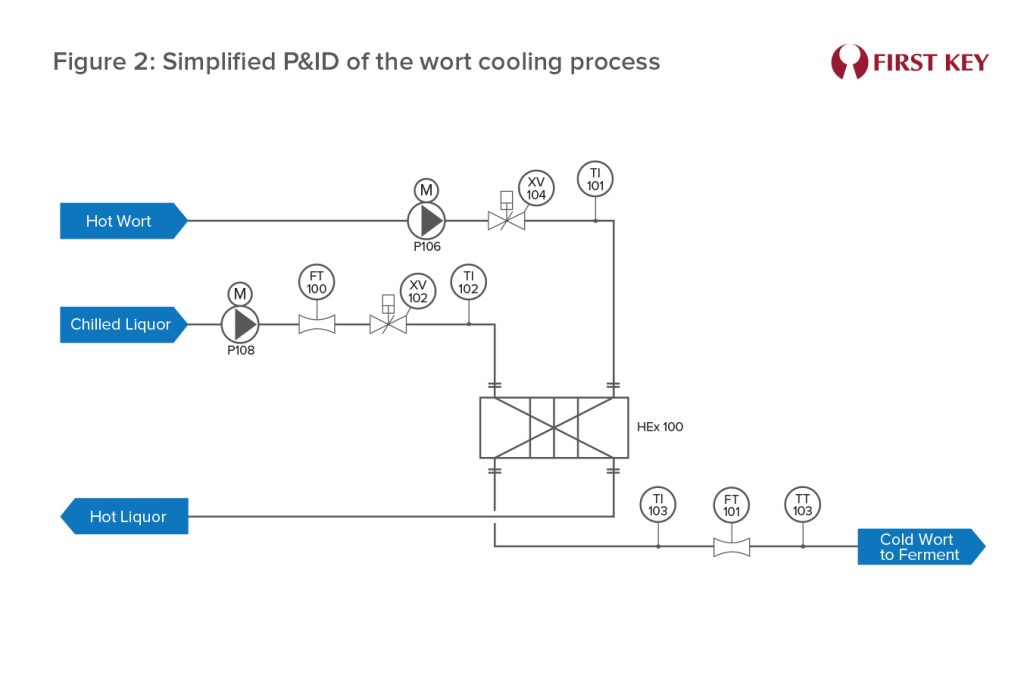
A. Identify Key Equipment/Processes
Here is a list of brewery equipment considered as significant generators or consumers of energy.
- Brewing process
- Mashing
- Wort boiling
- Wort cooling
- Packaging
- Bottle washing for returnable glass containers
- Pasteurization
- Utilities
- Boilers and associated steam and condensate return systemAir compressors
- Refrigeration
- Refrigeration compressors
- Condensers
A well-performed reliability analysis must specify the inclusions and exclusion, i.e., the equipment/process boundary.
B. Subdivide the Equipment/Process
This step consists of breaking the equipment/process into smaller modules so that they can be analysed effectively. The key is to categorize the elements that have a meaningful impact on energy consumption. The specialist must consider all other components such as the wort control valve XV104 in the maintenance plan but they do not count them in the same grouping. In this scenario, the list contains only two devices:
- The wort cooler plate heat exchanger, HEx100co
- Temperature transmitter, TT103
C. Define the Failure Modes
The failure modes for each subsystem need describing to understand why the equipment will stop functioning properly. This is essential to improve its reliability.
For the wort cooler example, we have selected these modes which have an impact on carbon emissions.
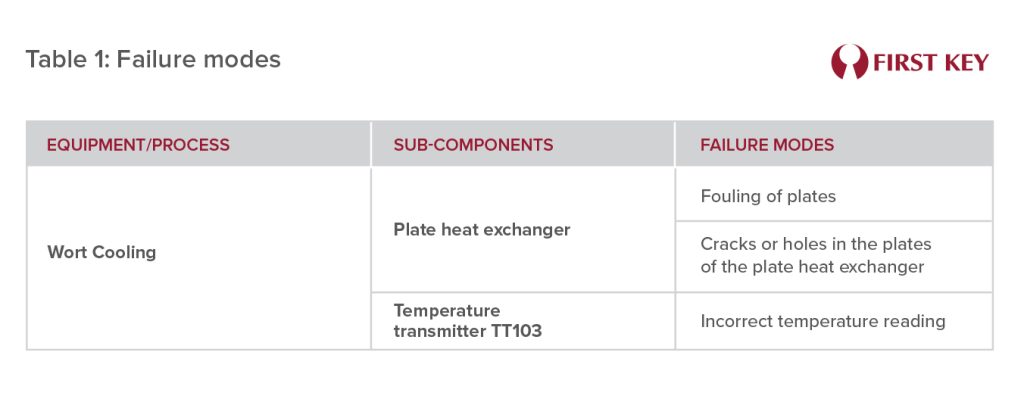
D. Define the Failure Effects
In this step, the plan describes what happens when the failure occurs.
Here is a table that clarifies the intent:
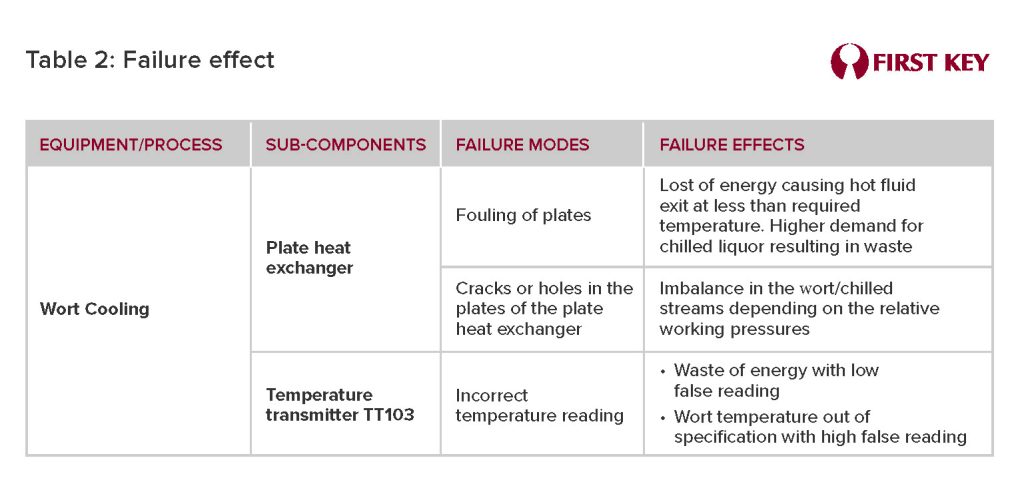
E. Define the Appropriate Maintenance Tasks
At this phase, the specialist defines the preventive maintenance task based on the failure effect by the 5 W approach:
- What preventive maintenance task is needed to avoid the equipment breakdown.
- Where one should conduct the task.
- Who must perform the task.
- When one should complete the task and at what frequency.
- How one should execute the task.
It is vital to establish the right intervention frequency for cost effectiveness. With too many verifications, you will be wasting resources while not enough may result in failure and productivity lost. For example, if you have executed a maintenance task ten times with no defects, then reduce its frequency. On the other hand, if you find defects every time then the frequency needs increasing. Initially, the precise occurrence is unknown so the technician can use a initial frequency/rate based on common sense. They may then calibrate the occurrences according to the condition assessment of the equipment encountered from each check.
An expert individual may refer to a probability Density Function Calculator; however, it requires a high level of reliability sophistication that is beyond the scope of this article. As a rough rule of thumb, aim for one corrective maintenance activity for every three preventive maintenance planned tasks. For the wort cooler case, here is an example of the preventive maintenance tasks in Table 3.

F. Update and Execute the Preventive Maintenance Plans
Once the full set of energy preventive maintenance tasks are developed, they are continuously updated to capture the knowledge from each verification and the renewed activity is re-executed as scheduled.
Summary
While technology investments are valuable for the organization in achieving carbon emission reductions, management usually overlook the importance of operations and maintenance efforts.
Using a simplified RCM process, it is possible to enhance a preventive maintenance program and lessen CO2 emissions. Often, results come at a modest cost in comparison to other more capital-intensive solutions.
To quote Benjamin Franklin, “We constantly change the world, even by our inaction. Therefore, let us change it responsibly.” Leverage your preventive maintenance system to diminish your carbon emissions and help yourself, our industry and humankind.
References:
- Boston Consulting Group. (2022). Exploring UK Consumer Interest in Sustainability. [Online] Available at: https://www.bcg.com/publications/2022/uk-consumer-interest-in-sustainability [Accessed 24 Jan. 2024].
- Mozny, M., Trnka, M., Vlach, V. et al. Climate-induced decline in the quality and quantity of European hops calls for immediate adaptation measures. Nature Communications 14, 6028 (2023). https://doi.org/10.1038/s41467-023-41474-5

